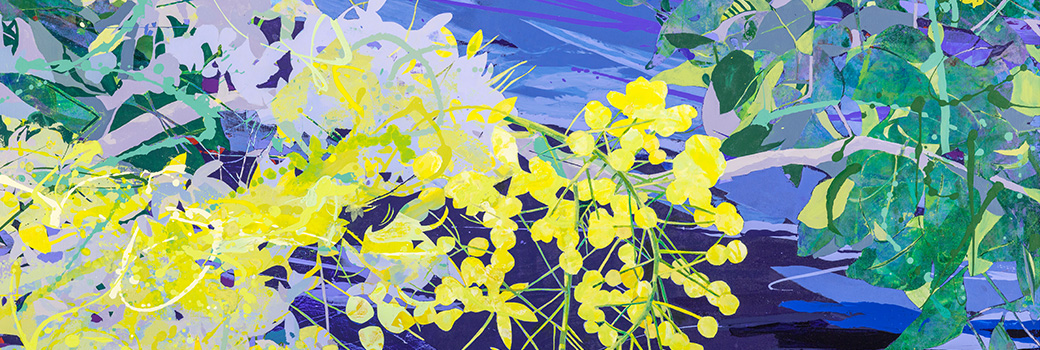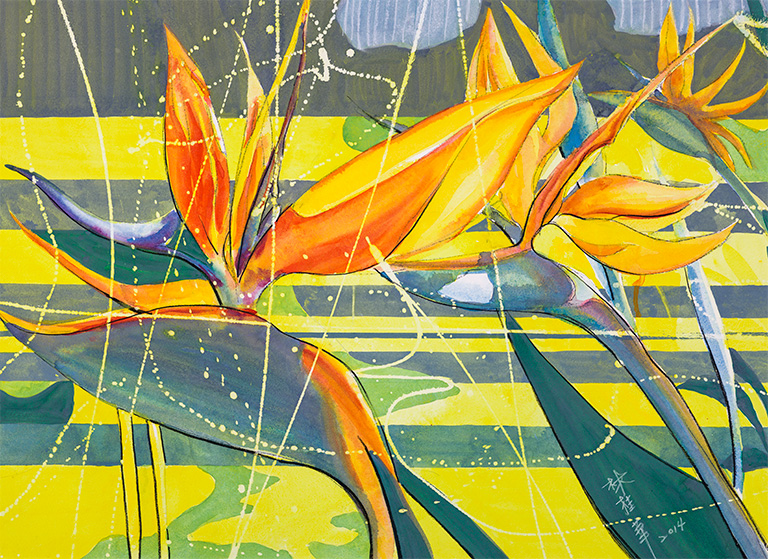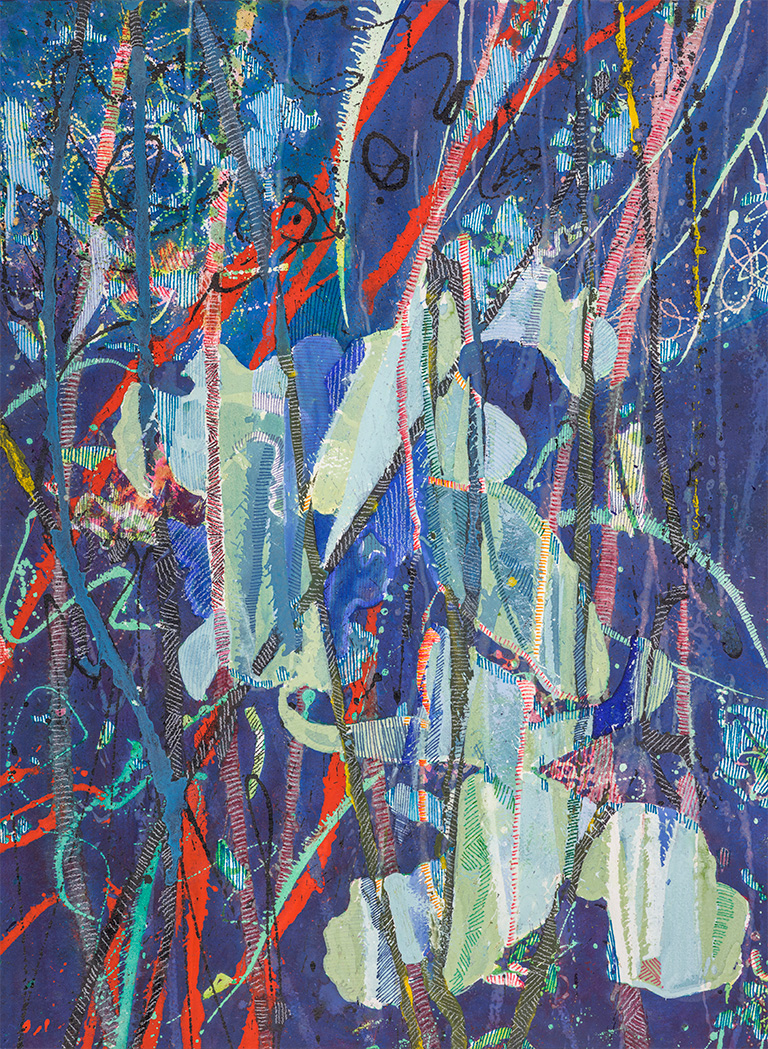
Painterly Superimposition

◎ Duration:2016.09.10 ~ 10.15
Location:See ART ╱ www.seeart.space
Address:No. 22, Ln. 60, Taishun St., Da’an Dist., Taipei City 106, Taiwan (R.O.C.)
Opening hours:Tuesday to Sunday 10:00 ~ 18:30
The drastic variation of human’s visual experiences caused by development of technology and changing lifestyle often influences the artistic expression we create. Consequently, artistic practice – or “the freedom of expression” as how we usually define it – celebrates not only the individual’s inner reaction but also the interrelation among one’s cultural experience, artistic context, the materiality of media, and the life journey of an individual. Similarly, the effects of three different visual experiences can be discovered in Kuei-Hua Lin’s works: first of all, the context of “painterliness” in the tradition of painting; secondly, the camera angle in photography; thirdly, the dislocation of printing or superimposition in the image-base art history.
To begin with, “painterliness” is a term commonly used in art history, opposite to the concept of linearity. Art historian Heinrich Wölfflin (1864-1945) has characterized the artistic transformation from Renaissance to Baroque as change of style from linearity to painterliness. According to him, linearity describes the clear and flat linear design popular in Renaissance art, while painterliness allow Baroque art to create a three-dimensional quality with curves, obscure contours, and a stronger chiaroscuro effect. The contrast somewhat summarizes the spectrum of Western art – the former is more classical and restrained while the latter is more emotional and expressive. In this respect, Lin”s art is close to the painterely concept. In her artmaking, she not only freedom of painting executed by her hand. Therefore, most of her previous works feature a greater spontaneity thanks to the flowing lines and dripping =effect of water-based pigments.
The second visual experience is related to photography. Her favorite composition is either an upward view or a close-up, a result of her habit of modeling photos of flora which she has taken in her journey. In fact, the increasing accessibility to photography has make it a tool in painting, but the real impact on the practice of painting is in its cultural and visual aspect that photography provides a new camera-based perspective beyond the traditional composition in painting. As a result, it is no longer required for painting to establish a well-developed storytelling scene but encourages it to focus on the fragmented, partial, instant, photographic image. Meanwhile, the detailed, close-up partial view further highlights the quality of painting as a form.
The third visual experience comes from the dislocation of printing and superimposition. Nowadays, we may feel familiar with these kinds of effects caused by printing errors, chromatic errors, photographic multiple exposure of intentional superimposition. Whether intentional or by mistake, the effects reveal the thin, flat, and accumulative quality of image itself. Examples can be found in the artmaking process of Lin’s recent works where she chooses various images of silhouette and makes them into several shaping plates, while she later applies layers of thick or thin acrylic paints on them. The direction of the strokes and shapes is often intersecting the shaping plate’s composition, crating three layers of images, including the one painted with the plate covering, with it half covering, and with it removes. The artmaking process reflects the thin-versus-thick relation between images and paints. With an intentional emphasis on its e=texture, it highlights a relief-like thickness variation between the part with plate covering and part without.
Lin’s artistic practice is inspired by her life. Simple subjects are her favorite, while the overall scene depiction in her earlier works is gradually replaced by partial views of flowers and fruits. Similar to Paul Cezanne (1839-1906)’s dedication to still life painting and Mont Sainte-Victoire, Lin also adopts simple scenes and objects to elaborate her exploration of shapes. Through the layers and artmaking procedure of her works, such as the techniques of emboss, fretwork, brushing, and reserving the background, we are invited into a dialogue between the layered painting and image itself.
– Curator╱Jian Liting


The Flower in the Wilderness:Kuei-Hua Lin’s Vision of Colors
Curator╱Wu Shu-An
As thin and transparent as a cicada’s wing, the glaze base featured in Kuei-Hua’s composition is a vivid contrast to its strong and powerful subject, reminiscent of Ma Yuan and Shia Kuei’s “one-corner composition.” Polished like a jade, rough like a rock, stirred like bubbles – it is not only our first impression of Lin’s works but also the charm of them, a series of paintings finished with precision, intensity, contemporaneity, and clever subtlety.
Brush Walking: Eyes, Brain, Hands, and Heart
Although how we paint is always based on how we plan, Lin, like Gille Deleuze’s analysis Francis Bacon, begins with destroying any pre-established rules concerning the image itself and her own imagination, allowing her hand to lead the action. After rounds of adjustments, the work is finally completed. She seldom abandons what she has already finished. No one can imagine what she has been through and what measures she has taken throughout the whole artmaking process. For her, painting is her labor-intensive work. The days spent in her studio, where she takes advantage of the color spectrum of natural lighting, crystalize her labor into a precious gem. The great amount of water-based pigments used in her works such as watercolor or acrylic paint reveals her eagerness to express herself through art and to establish her signature. She also utilized a palette knife to scratch and flatten the base paint, making it a thin transparent membrane, on which the artist creates a layered plane of splendid visual intensity characterized with splash, script, and scrape. The subject of the paintings does not seem to be a priority to Lin, After all, it is quite impossible to find an untouched subject in the category of figurative painting. Therefore, Lin focused more on the techniques. She lets her eyes and hands to replace mind and brain. The paint’s spontaneous flow follows the movement of the hand, establishing a unique artistic style different from any painter before her.
Allowing the had to move before thought does not suggest that the artist reject any consciousness in painting. Instead, she lets the strokes and paint to stretch freely on the canvas, while the result of what they grow into is again polished and adjusted carefully by the artist. Lin’s paintings are complicated for that they have been through laps and twists. However, it is the only possible way for the artist to locate herself and to establish her artistic signature, just like those great painters before her.
Painting: The Layered Past
The reward of her technique-exploring is the surprising and unexpected artmaking process demonstrated on her works. Examples include needle splash, the use of palette knives, or the transformative and diverse textures crated on the dried flat acrylic maintaining a rich, solid, flowing, and organic visual quality. The simple elements are carefully arranged with Lin’s perfect subtlety, while the randomness is the interaction between consciousness and spontaneity. “Thought before strokes,” it is not to say that her works ack consciousness, but the random brush walking is the only way to fight against a tradition of painting which is heading toward its own end and to establish a unique artistic expression. Lin’s painting is lively and spontaneous while it is also rational and discreet. I am not suggesting the artist’s works are overwhelmed by contradictions, but the balance between the two helps achieve the most satisfying consequence – brisk but yet modest personality, highlighted with the strongest visual impression as her tour de force.
The artist often rejects the conventional practice of chiaroscuro. Instead, she utilizes a large scale of strong colors to visualize intensive shapes, creating a double-edged effect as the abstract expression captures the spirit of the object. In other words, we see the tree, and we also see the forest. She loves painting flowers and fruits, but she does not follow the traditional still-life composition which we have been familiar with. The partial view of the close-up makes the image more abstract, and the powerful contrast harmonized with nature is the most precious source, just like the natural breeze and light hidden beneath the sculpted layers.
A Brisk Breeze: The Waltz of Nature
Lin’s art is bright and precise, but the diverse potentialities also demonstrate her adventurous determination. She pursues the enchanting visual experience, while she also attempts to visualize a vigorousness in her paintings. The dominant portion of strong colors seems menacing, but you will soon find in it a perfect execution of subtle and rapid strokes if you take a closer look. The visual effect is sober and yet rich, like a lively waltz in the brisk breeze, revealing both the excitement and sweetness of flowers and fruits. The most distinguishable is the almost primitive vitality, the labor-intensive process of the painting gathering the effort of mind, hands, brain, and eyes. The artist believes that to begin with actions (“painting strokes” to be precise) is the only way to achieve originality. Such a trick rule she sets up for herself is how she avoids repetition and insipidity, while it also allows her to create a conflicting but yet balanced image.
The risk-taking journey to search for one’s uniqueness encourages the artist to keep exploring new styles and expressions every time when she finishes several paintings in a series. It is never easy quite challenging and risky indeed. However, Lin’s uncompromised artistic practice and dedication has made the adventure conquerable, replacing obstacles with a continuity of constant diversity. Here, we see a different Lin – a brave and fearless challenger that no threat of failure will stop her in this journey toward absolute originality. The painting brush silence our eyes, offering a moment of meditative serenity between viewers and paintings. Meanwhile, viewing becomes a pleasant experience for viewers to hit the road with the painter. Her artistic journey continues, as she rejects to give up her experiment and the attempt to make a breakthrough. We surely will wait for her to make a new turn, where we may be welcomed by a totally different vision, though derived from the same narrative – the style without a style, the determination to take challenges, the experimental techniques, and the surfacing to a wonderful vision.,
